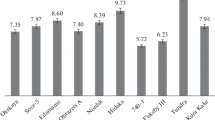Abstract
Chemical data regarding the protein content and quality of the tuberous roots of four grain legumes suited to cultivation in the humid tropical lowlands are presentend. Crude protein was estimated as a product of % nitrogen in the meals extracted with 70% (v/v) ethanol x 6.25 and the amino acid composition of the proteins was estimated by analysis of meals after extraction with ethanol. The crude protein value for the meals ranged between 3.9% and 14.1% on a dry weight basis and the amino acid profiles were nutritionally acceptable in comparison with that of the FAO reference protein, except for the sulpho-amino acids. Nodulating and mineral nitrogen regimes during plant growth did not change the nutritional value of the tubers.
Similar content being viewed by others
References
Evans, I.M. & Boulter, D. (1974). Chemical methods suitable for screening for protein content and quality in cowpea (Vigna unquiculata) meals.J. Sci. Fd Agric. 25:311–322.
Evans, I.M. & Boulter, D. (1975). Amino acid composition of seed meals of yam bean (Sphenostylis stenocarpa) and lima bean (Phaseolus lunatus).J. Sci. Fd Agric. 25:919–922.
FAO/WHO (1965). Protein requirements: report of a joint FAO/WHO expert group.FAO Nutrition Meetings Report Series No. 37.
Heidelbaugh, N.D., Huber, C.S., Bednarczyk, J.F., Smith, M.C., Rambaut, P.C. & Wheeler, H.O. (1975). Comparison of three methods for calculating protein content of foods.J. Agr. Fd Chem. 23:611–614.
National Academy of Sciences (1975a). The Winged Bean. A high-protein crop for the tropics.National Academy of Sciences, Washington, D.C., pp.43.
National Academy of Sciences (1975b). Underexploited tropical plants with promising economic value.National Academy of Sciences, Washington D.C., p.56.
Pospisil, F., Karikari, S.K. & Boamah-Mensah, B. (1971). Investigation of the winged bean in Ghana.World Crops 23:260–264.
Purseglove, J.W. (1968). Tropical Crops: Dicotyledons. Longmans, Green & Co. Ltd., New York, p. 281.
Rachie, K.O. & Roberts, L.M. (1974). Grain legumes of the lowland tropics.Adv. in Agronomy 26: p.89.
Author information
Authors and Affiliations
Rights and permissions
About this article
Cite this article
Evans, I.M., Boulter, D., Eaglesham, A.R.J. et al. Protein content and protein quality of tuberous roots of some legumes determined by chemical methods. Plant Food Hum Nutr 27, 275–285 (1977). https://doi.org/10.1007/BF01092320
Issue Date:
DOI: https://doi.org/10.1007/BF01092320




